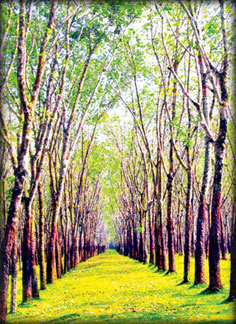RRI, the driving force of the rubber industry
by K.K.D. Premalal - Matugama Daily News Special Cor
Many products made of rubber are available for safety, comfort,
protection and pleasure. Teats, balloons, balls, bathing caps, condoms,
tyres, toys, erasers, inner tubes, cast products, slippers and shoes are
some of the products manufactured using rubber. The rubber industry is
the second largest industry in the world after iron and steel.
|

Dr. Priyani Seneviratne, Head, Plant Science Department of the
RRI. |
|

A rubber plantation |
In England, Joseph Priestley, best known for his discovery of oxygen,
noted that pencil marks could be "rubbed out" by the substance. From
this early use, rubber derived its name.
Vision
The rubber tree (Hevea brasiliensis) has a smooth bark, compound
leaves and small inconspicuous flowers. The seeds are akin to castor
beans.
On ripening , the fruit explodes and propels the seeds away from the
trees. The motherland of the rubber tree is the Amazon jungle in South
America. With the discovery of vulcanisation and other technological
advances, the demand for rubber has increased.
In the 1870s Brazil was the only producer of rubber to the world
market. Sir Henry Alexander Wickham is the man who introduced rubber to
Sri Lanka and other Asian countries.
The first rubber tree was planted in 1876 at Henarathgoda Botanic
Gardens.
The Rubber Research Institute of Sri Lanka (RRI) in Agalawatte is the
driving force of the oldest of its kind in the world. Research carried
out for more than a century has provided us a wealth of knowledge and
information on new technologies to improve the productivity of rubber
lands and development of numerous types of rubber products. Today a
large number of scientists and supporting staff work tirelessly at the
institute developing new clones, improving agro management practices and
innovating technologies for raw rubber processing and products. Some of
the clones developed by the RRI has won international recognition for
their productivity and resistance to various kinds of diseases.
The vision of the RRI is to emerge as the centre of excellence in
providing high quality scientific technologies to the rubber plantation
industry. According to the Rubber Research Ordinance, the Rubber
Research Board under the Ministry of Plantations is the governing body
of the RRI of Sri Lanka.
Rubber-Rice Pact
A devoted and dedicated staff functioning under 17 departments and
units have a mission to revitalise the rubber sector by developing
economically and environmentally sustainable innovations and
transferring the latest technologies to the stakeholders through
training and advisory services.
The RRI in Agalawatte, is about 15 kilometres away from Matugama on
the Agalawatte Road. It is surrounded by dense rubber plantations on
moderately hilly terrain.
The site provides a conducive environment for scientists to carry out
their research work.
The zig zag route leading to the destination is a pleasant sight
indeed. The RRI is a "must see" for those interested in learning about
this wonderful tree and the huge industry based on its products.
The origin of research of rubber goes back to 1909, when a group of
planters in the Kalutara district met and agreed to engage a chemist to
study the coagulation of rubber.
This marks the beginning of scientific research on national rubber in
the world.
Various research has been made ever since towards the development of
the rubber industry. The RRI has emerged as one of the leading research
organisations with international reputation.
In the early 1950s Sri Lanka faced a rice crisis and there was a
considerable escalation of its price in the world market. It was in this
grim setting, the historic Rubber-Rice Pact between Sri Lanka (then
Ceylon) and the People's Republic of China was signed in 1952. R.G.
Senanayake, the then Minister of Trade and Commerce signed the pact with
his Chinese counterpart.
Senanayake found that China was ready to give rice to Sri Lanka in
exchange for rubber. The Ceylon - China trade agreement is undoubtedly
the most useful one signed by both countries. On the other hand, this
was the first trade agreement signed by China with a non-communist
country. This year marks the 61st anniversary of the historic
Rubber-Rice Pact between Sri Lanka and China. The RRI's Plant Science
Department Head Dr. Priyani Seneviratne said, "We have introduced a new
system for planting rubber in home gardens using rubber clones with high
productivity. This will help earn an extra income for families who
possess small home gardens. The distance between two trees should be 20
feet and it will certainly help cultivators to produce high quality
rubber latex. Therefore, if a family owns 10-15 of such trees, a good
income is guaranteed over a long period of around 25 years. Having a few
such trees in the home garden would be a kind of an insurance scheme for
the family as the crop can be obtained when the need arises.
In other words, rubber is one of the privileged trees which can store
the crop within , for the farmer to utilise when he is in need of it.
The RRI is prepared to give clones to cultivators and provide them with
instructions.
She said, "A program has been launched to cultivate rubber in the
Northern Province with the assistance of the Ministry of Plantation
Industries. Minister Mahinda Samarasinghe is keen on expanding the
rubber industry in different parts of the island. Under the project
Palali, Vavuniya, Kilinochchi and Ampara have been selected to cultivate
rubber. This year's target is to distribute 12,000 clones to cultivators
free. Rubber trees have a cooling effect on the environment. When
cultivating rubber, it will be a boon in the Dry Zone where the climate
is dry and rain is not regular.
Extra income
Rubber cultivators can generate extra income during the immature
period of rubber plantation by integration of other crops. Crops
suitable for inter-cropping during the immature phase of rubber are
banana, pineapple, passion fruit, sugarcane, cardamom, vanilla and
cocoa. Growing anthurium under mature rubber trees provides an
additional income to the rubber planters.
The shade provided by the trees reduce the cost of artificial
shading. The rubber tea inter-crop is well suited to the wetter regions
where sole cropping of both rubber and tea is practised. Under normal
circumstances, rubber cannot be tapped very often during the rainy
season and farmers can still obtain an income from tea harvests. Also in
large estates, the inter-crop secures job opportunities for estate
workers.
The RRI has introduced a new rain-guard system which enables to tap
rubber even on rainy days. The rain guarding technology introduced to
the industry is a grower-friendly and it is highly economical.
The RRI has also introduced a technically improved tapping knife
which can tap latex without damaging the tree. It also helps to extract
maximum quantity of latex.
The new tapping knife is available at the RRI in Agalawatte and board
office and Rubber chemistry laboratories in Ratmalana.
There are several challenges confronted by the natural rubber
industry in the world. Synthetic rubber has become a big challenge and
it has captured the major part of the world market.
However, there is a resurgence in rubber plantation because more and
more people are planting rubber because there is a ready market in the
world. |



